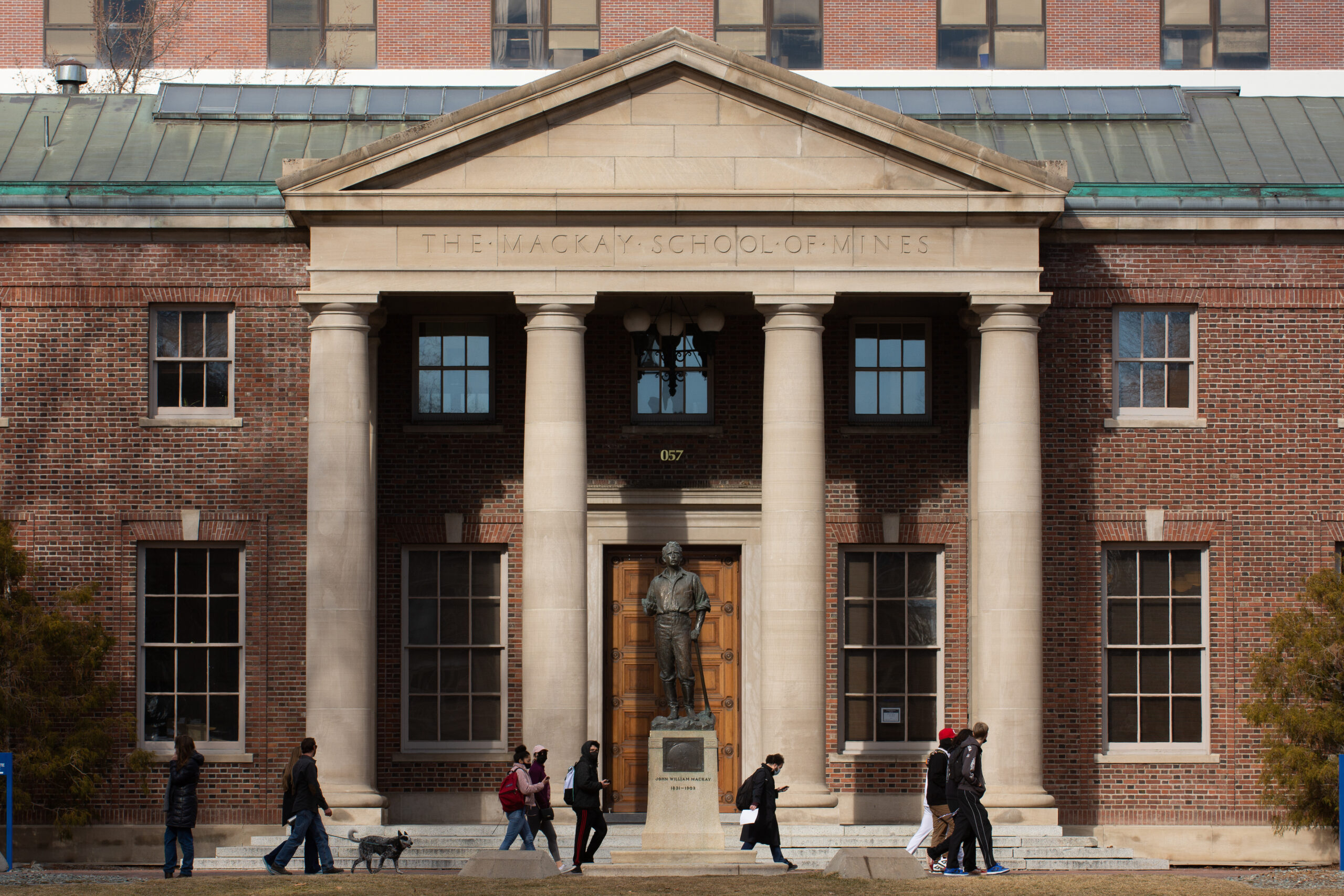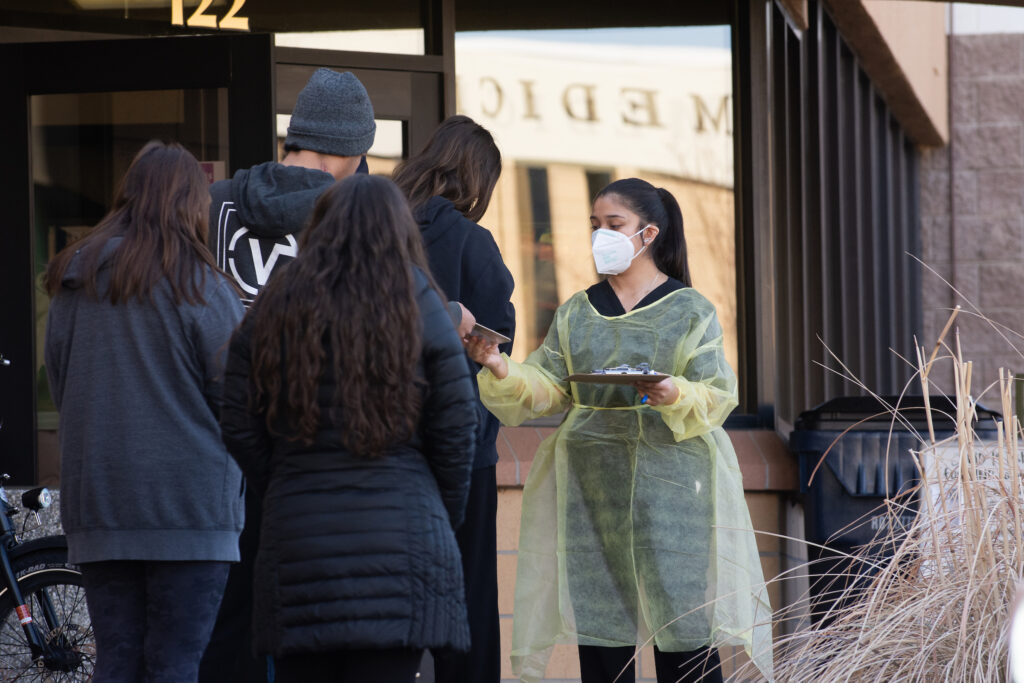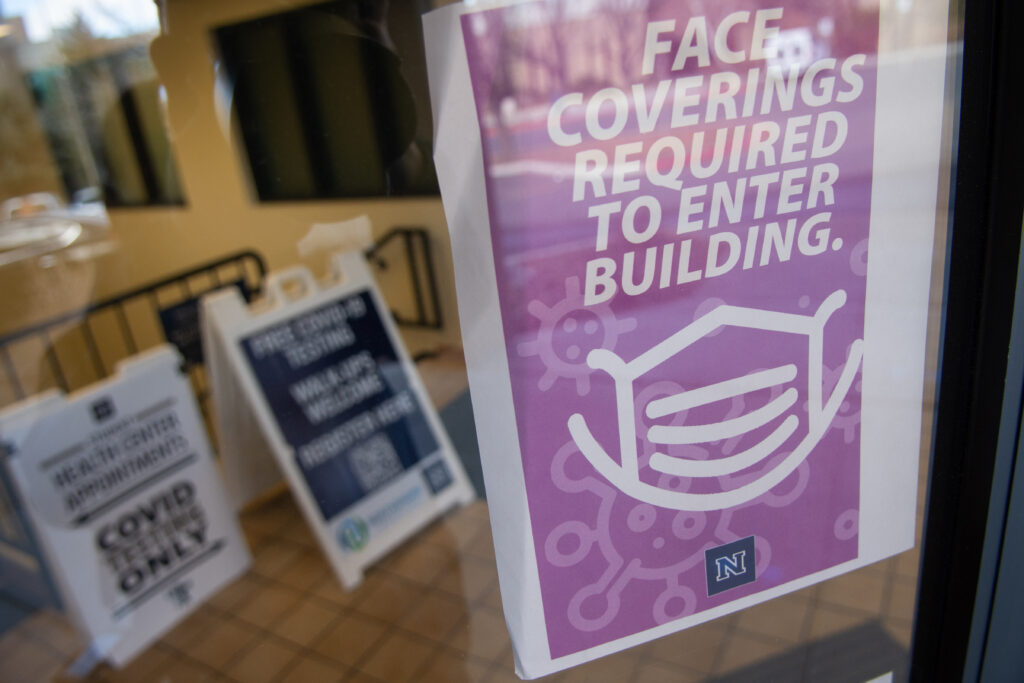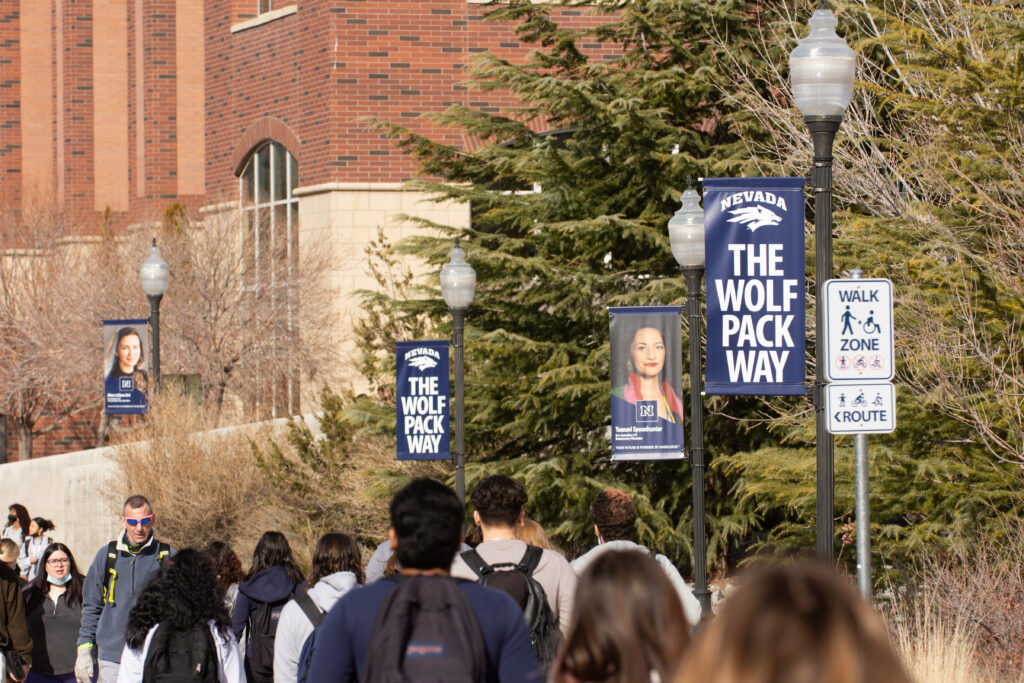UNR faculty, students question full return to in-person learning as Omicron surges

Roughly 21,000 students returned to class last week for spring semester at UNR, where after more than two years of COVID-related disruptions, changes and mitigation policies, students, faculty and administrators are eager to get things back to normal.
UNR — where one out of six students lives in on-campus housing — is unique among the state’s higher education institutions in its ongoing efforts to keep nearly all of its instruction in person through these newest phases of the pandemic.
Last fall, as concerns over the Delta variant grew alongside spiking case counts, UNR began the semester with roughly 90 percent of its offerings fully in person. This spring, the math has changed only marginally, with 88 percent of classes offered in person amid the fast-spreading Omicron variant.
“We are probably the most residential campus,” Provost Jeff Thompson said in an interview. “So moving here and having an online experience is very different from commuting to a location of higher education … that is part of University of Nevada, Reno, and it is a priority because it's part of our students' expectations.”
The value of in-person learning, compared to the often-maligned “Zoom school” that defined the early pandemic period of 2020, has been universally praised as the ideal, according to students, graduate students, faculty and administrators who spoke to The Nevada Independent for this story.
“We all were looking forward, back in November, to fully in-person structure instruction,” said Kent Ervin, president of the Nevada Faculty Alliance (NFA) and a UNR professor. “Faculty and students both want that.”
But the new reality presented by the Omicron variant has tested every facet of the university apparatus and strained relationships between some faculty and administrators.
In the short few weeks of the winter break, higher education plans for the spring were swallowed by chaos, as the now-emerging Omicron was met with the functional end of a COVID vaccine mandate for Nevada college students.
A casualty of a partisan deadlock on the Legislative Commission, the mandate was still active for nearly two months, starting Nov. 1. In that time, tens of thousands of college students did receive a vaccine or prove their vaccination status, including at least 18,000 students at UNR.
But as Omicron cases surged across the state, mitigation strategies system-wide largely continued to mirror efforts from the fall.
As a result, just days before the semester began, the UNR chapter of the NFA sent a letter to members calling for a two-week pause on in-person instruction and arguing that the decision to hold a class online — a choice left to the provost’s office under UNR policy — is instead a matter protected by academic freedom.
“Individual instructors are endowed with academic freedom not only to teach content they deem necessary, but also the academic freedom to deliver that content in ways they deem necessary,” the NFA wrote.
The letter was a marker of things to come, as a vocal contingent of faculty would come to clash with administrators over rules they said put their own health and the health of their families at risk, with little to no recourse.
It is a claim administrators have denied, pointing instead to a push from students and parents for in-person instruction and little evidence that — even if infections are rising among the campus community — they can be traced back to the classroom.

The surge comes to campus
Less than a week into the new semester, case counts among students and faculty reached record highs at UNR, with 113 student positives reported last Tuesday and another 102 reported on Thursday. As of Monday, the test positivity rates for both students and faculty had exceeded 30 percent.
To that end, UNR Student Health Center Medical Director Cheryl Hug-English said demand for on-campus testing from faculty, students and staff has increased accordingly and necessitated the opening of another testing facility at the student union this week.
Hug-English also said the demand has increased time for results on the more-accurate PCR tests, though all tests come with an rapid antigen test that, she said, allows university health officials to begin contact tracing immediately if they suspect a positive test result.
“There are occasionally cases where the antigen test may not pick it up, a PCR is more sensitive and will pick up those cases, so that's why we do both,” Hug-English said. “But again, if someone is positive on the antigen test, the assumption is they’re a positive case and we do contact trace and advise isolation based on that test.”
That contact tracing has so far guided decision-making, according to both Thompson and Hug-English. Ultimately, Hug-English pointed to an important distinction in the underlying data of the new Omicron wave at UNR, which bears a key similarity to past waves of Delta and beyond: new cases are not being traced to the classroom and the lecture hall.
“The cases that we're seeing are cases that are not tied to classroom settings, but tied to other exposures,” Hug-English said. “And unlike a year ago, when things were more closed down and restaurants were not available and sporting events were not available and concerts were unavailable, there are a lot of things that people are doing and going to and participating in.”
Hug-English said that an increase in cases generally — even in the campus community — does not create sufficient evidence that classrooms, themselves bound by mask mandates and buoyed by high vaccination rates, are new centers for Omicron’s spread.
The number of positives per 100,000 people has surged statewide, but the increase has been particularly acute in Washoe County, where the number of cases per 100,000 reached a new high of 318.18 Monday — roughly 30 percent higher than the Clark County peak of 220 per 100,000 recorded in mid-January.
“We are going to see cases on our campus just like we're seeing in our community, and right now we are seeing increased case numbers — just as we are in our community,” she said. “But again, I think that being on campus — we're doing everything we can to promote their health and safety and I think that the classroom situations have not been shown to be locations where we've seen increased spreads.”

A clash over ‘flexibility’
At UNR, as elsewhere, policies are in place that are meant to handle the logistics of the pandemic in the classroom. Though most classes are in person, professors can request certain accommodations for personal circumstances, and instructors who catch COVID or are exposed to the virus do have their classes moved online during their isolation period.
But some instructors have charged that the system is too rigid for the fluid situation presented by Omicron, and does little to assuage concerns over safety in the classroom. For Todd Ruecker, an English professor at UNR, “there’s no spirit of shared governance” in a situation that he said has reached a new “level of absurdity.”
Ruecker is among those faculty calling for a two-week pause to allow the worst of the Omicron wave to pass. In particular, he echoed sentiments from fellow faculty that any online shift would be a temporary solution, that “we don’t want to be online for too long, we don’t want to be online for the semester.”
“Instead, they sent someone from the Provost‘s Office to walk around our building,” Ruecker said.
That act — the individual checking of classrooms by officials from the provost’s office to confirm that classes are still being held in person — has become a flashpoint for faculty already skeptical of the university’s COVID response.
“Our positivity rates on campus are unprecedented, the graphs I saw from the Student Health Center [Wednesday] document exponentially higher positive test rates on campus and at any other point in the entire pandemic,” said Ashley Marshall, a professor and chair of the UNR English Department. “If you could juxtapose that with photos of one of the vice provosts walking the halls of the English department with a clipboard, making sure everyone is stuffed into those tiny classrooms — that's pretty damning.”
Marshall said the department received an email listing 11 classes that should have been in person but were not, out of roughly 100 classes total that were being held that day. Among those 11, she said, five were instructors who had been exposed to COVID, were symptomatic or had tested positive.
Thompson denied that vice provosts under him were proactively checking classrooms to ensure instructors were still teaching in person, and said instead that checks were only made in response to complaints received by the office.
“As soon as classes started, we started getting complaints from parents, from students, and from elected officials about classes that were not in person,” Thompson said.
Thompson said that his office “always checks those,” but added that the reasons behind those complaints were often mundane — from a last-minute change in an instructor, to instructors catching COVID and needing to move temporarily online, to a class that was always meant to be online, but drew a complaint for not being in person regardless.
Thompson conceded that “we’ve had a few” faculty who had moved classwork online “without permission,” and that “we have a discussion on how we address that going forward.”
Still, he said, “this is very normal for us.”
But even among those who might concede that a full pause on in-person instruction is unlikely, calls for added latitude for individual departments and deans have remained, in part because Omicron cases are still disrupting the in-person experience, even if the spread has yet to be traced directly to the classroom.
Robert Ostergard, a political science professor, said that a class of 32 students had already been hit with 10 positive cases, leading to new questions over how a third of his class should be accommodated now that they cannot come to class.
“The policies that are put in place right now is that we're supposed to be able to accommodate all those students,” Ostergard said. “But at some point, you get to a situation where the numbers start to really outweigh what you're doing. So if I’ve got a third of my students who are COVID positive right now and can't attend, then what does that mean in terms of me going back and having to do lectures over for them, or having to go ahead and extend assignments out?”
One solution, according to a half-dozen faculty members who spoke to The Nevada Independent: flexibility.
“Even though Omicron is going to, eventually, fade, I don't think that we're out of this yet,” Ostergard said. “We're going to see additional variants and mutations. And if that's the case, then we need to be better prepared for this and we need to have a little bit of flexibility in order for instructors and students to get through these types of waves that are going to occur.”
At all levels of instruction, however, instructors say flexibility is absent as administrators have largely denied requests to accommodate health needs.
That includes graduate students — who frequently supplement and assist faculty through university-sponsored teaching assistantships — and who also have raised concerns that they have little recourse if they or their family may have health concerns
Emily S. is among those graduate teaching assistants. She asked that The Nevada Independent not disclose her last name, citing concerns that she may be doxxed or retaliated against for speaking on the issue.
“I feel like if we've learned anything over the past years of the pandemic, COVID requires nuance and flexibility and adaptability,” Emily said. “Instead, the one message that we're getting from university admin is — it has no nuance, it is flat, it is black and white. It is just what they say, and what they say is we are being in person, period.”

The view from the institution
Provost Thompson, whose office sits atop the academic food chain of the university and is charged with making decisions on exceptions and carve-outs to existing COVID policy, acknowledged that UNR was prioritizing in-person instruction, and said university officials met weekly to discuss potential changes based on metrics that are monitored daily.
“This is a very dynamic and sometimes chaotic process,” Thompson said. “The changes in everything from federal guidance on how to best quarantine and isolation to understanding the risk associated with being vaccinated and unvaccinated and also …how infectious this version of Omicron is, and how dangerous it is.”
The focus on in-person has long been articulated from the very top of UNR, and President Brian Sandoval said as much in a welcome-back letter to students for the spring that also touted 18,000 students — roughly 86 percent of the 21,000 students total — had been vaccinated, alongside testimonials from both the undergraduate and graduate student body presidents.
“The vast majority of our students have been very clear in their wish to have an in-person educational experience, which we delivered successfully during the fall semester with public health measures in place to protect our Wolf Pack Family,” Sandoval wrote.
Thompson described the university’s process, like Hug-English, as prioritizing whether or not classrooms were becoming hotspots for transmission, rather than any blanket push for two weeks of online instruction. In doing so, he likened the policy to a similar effort last semester.
“If the caseload looked large in a class, we asked them to go online for two weeks,” he said. “So we're going to continue to do this — but we're doing it as an individual course. We're not doing it at the campus [level] because we have not seen evidence of campus transmission going on as part of the educational process.”
Thompson also said that the university had sought to be proactive in some mitigation measures, especially on the issue of masks.
As some faculty — including those interviewed for this story — have criticized the lack of more stringent guidelines on what constitutes an acceptable face covering, Thompson and Hug-English confirmed the university recently ordered 20,000 KN95 masks that could be distributed on-campus.
As of last week, those masks had not yet arrived.
But on the issue of trust between faculty and top administrators, Thompson said the “dynamic” nature of the pandemic coupled with the slow-moving nature of higher education has made the situation more difficult.
“I think there is an issue at the moment that a lot of our processes are slow,” Thompson said. “If we're making sure that our decisions are equitable and lawful and a surge [of accommodation requests] comes on … It's hard for us to do that in a few days.”
But not all faculty have bought the argument that it is the university's size that has slowed its response.
“This is something that in a collaborative sense could be done, and everybody could find a happy medium with this,” Ostergard said. “This is something that could be changed relatively rapidly.”
All the while, the uncertain future course of the COVID pandemic continues to stress the workforce itself.
A dozen faculty members, graduate students and administrators interviewed for this story all pointed to an ongoing and increasing fatigue, as the crushing weight of the pandemic on every facet of the higher education apparatus has pushed against cracks and seams that were, in some ways, already strained before COVID ever became a crisis.
“There is no adjective sufficient to describe how devastated people are right now,” Marshall said.
